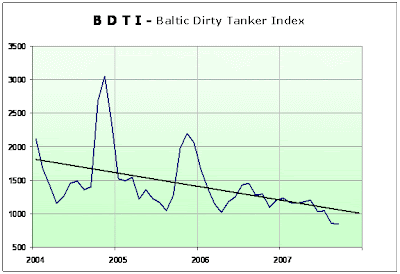GMR third quarter profit falls 54%
GMR Announces Third Quarter Results
Oct. 31
PRNewswire-FirstCall
General Maritime Corporation today reported its financial results for the three and nine months ended September 30, 2007.
Financial Review: 2007 Third Quarter
The Company had net income of $10.9 million, or $0.36 basic and $0.35 diluted earnings per share, for the three months ended September 30, 2007 compared to net income of $24.0 million, or $0.78 basic and $0.76 diluted earnings per share, for the three months ended September 30, 2006. The decrease in net income was principally the result of lower voyage revenues attributable to a generally lower rate environment in the third quarter of 2007. The impact of lower rates on the Company was mitigated by the Company's increased time charter coverage at rates above current spot rates. Results for the 2007 period also reflected higher interest expense due to increased borrowings to fund our $15.00 special dividend in March 2007 and increased off-hire days due to longer then anticipated drydockings and one accelerated drydocking in the third quarter of 2007.
Peter C. Georgiopoulos, Chairman, Chief Executive Officer and President, commented, "During the third quarter of 2007, we continued to benefit from the strategic decision we made over a year ago to place a significant portion of our fleet on accretive time charters. The considerable success we have had in this important area is testimony to our strong reputation in the industry and unrelenting focus on effectively managing the Company's assets through the shipping cycles. Complementing our solid results for the third quarter, we declared a third quarter dividend of $0.50 per share, our third consecutive dividend under the Company's fixed annual dividend of $2.00 per share. Including this quarterly dividend and the $15 special dividend we paid on March 23, 2007, General Maritime has distributed dividends of $24.78 per share to shareholders since 2005. With 70% time charter coverage for our fleet on the water, we have contracted revenues of $191.8 million for 2008, which positions the Company well for our $2.00 fixed dividend target while maintaining upside potential to benefit from any rate increases in the future."
Included in net income of $10.9 million are a $3.4 million unrealized non- cash gain associated with the change in fair value of our freight derivative as well as a $1.3 million gain associated with monthly cash settlements of our freight derivative, both of which are included in Other (income) expense.
Net voyage revenue, which is gross voyage revenues minus voyage expenses unique to a specific voyage (including port, canal and fuel costs), decreased 12.2% to $49.1 million for the three months ended September 30, 2007 compared to $55.9 million for the three months ended September 30, 2006. EBITDA for the three months ended September 30, 2007 was $31.0 million compared to $34.0 million for the three months ended September 30, 2006 (please see below for a reconciliation of EBITDA to net income). Net cash provided by operating activities was $18.5 million for the three months ended September 30, 2007 compared to $15.6 million for the prior year period.
The average daily time charter equivalent, or TCE, rates obtained by the Company's fleet decreased by 15.9% to $30,176 per day for the three months ended September 30, 2007 from $35,886 for the prior year period. The Company's average rates for vessels on spot charters decreased by 51.9% to $18,246 for the three months ended September 30, 2007 compared to $37,994 for the prior year period.
Total vessel operating expenses, which are direct vessel expenses and general and administrative expenses, increased 7.1% to $22.6 million for the three months ended September 30, 2007 from $21.0 million for the three months ended September 30, 2006. Direct vessel operating expenses increased 15.5% to $12.7 million from $11.0 million, while general and administrative expenses remained flat at $9.9 for the same periods. The average size of General Maritime's fleet increased 7.8% to 19.4 vessels in the third quarter of 2007 from 18 vessels in the prior year period. On a daily basis, direct vessel operating expenses increased 7.2% to $7,125 during the quarter ended September 30, 2007 compared to $6,645 for the prior year period. This increase can be attributed to cost associated with bringing the technical management of two of our Aframax vessels in-house and the write off of certain expenses reflecting insurance claim deductibles as well as increased premiums reflecting the increased value of our fleet.
Financial Review: Nine Months 2007
Net income was $39.4 million or $1.29 basic and $1.25 diluted earnings per share, for the nine months ended September 30, 2007 compared to $134.4 million, or $4.24 basic and $4.13 diluted earnings per share, for the nine months ended September 30, 2006. Net voyage revenues decreased 16.0% to $161.9 million for the nine months ended September 30, 2007 compared to $192.9 million for the nine months ended September 30, 2006. EBITDA was $91.6 million for the nine months ended September 30, 2007 compared to $165.0 million for the nine months ended September 30, 2006. Net cash provided by operating activities was $79.6 million for the nine months ended September 30, 2007 compared to $135.4 million for the prior year period. TCE rates obtained by the Company's fleet decreased 4.4% to $33,002 per day for the nine months ended September 30, 2007 from $34,508 for the prior year period. Total vessel operating expenses remained relatively flat at $70.3 million for the nine months ended September 30, 2007 compared to $70.7 million for the prior year period, and daily direct vessel operating expenses rose 9.3% to $6,777 for the nine month period ending September 30, 2007 from $6,203 from the prior year period.
